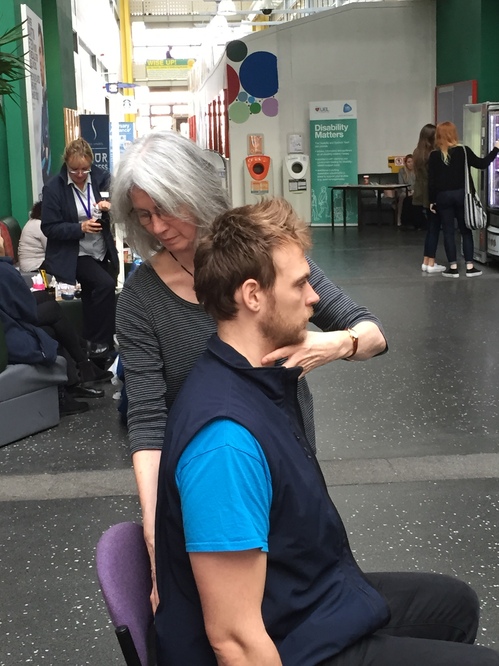Teaching for over 35 Years
Back in 2022 I reached a milestone, having been teaching the Alexander Technique for 35 years. I am grateful that I’ve been able to help hundreds of people over this time. Also, the Alexander Technique has been such an invaluable asset for me and it really is a skill for life. Not only is my work something that I love doing (and pays my bills) but it also helps me personally whilst I teach it. How does it do that? In order to convey the idea of Alexander work through my hands as I touch clients, I need to simultaneously think about my own body use. If you like, I also give myself an Alexander lesson. The AT is a great example of self-care and lifelong learning.

Alexander teachers think about our own body use whilst teaching others
Self-Help Skills
Over the years, the Alexander Technique has been a wonderful tool I have used to help myself. When I started learning, as a mature student and single parent doing a degree, the AT helped me manage my stress levels and a back injury I had gained as a teen during ballet training.
Some years after I qualified as an Alexander teacher, I had a major operation followed by a long period of Chronic Fatigue Syndrome, CFS. Being able to use the technique aided my recovery. It helped me pace myself and to avoid getting into lots of unhelpful habits of body Use whilst being so depleted.
Do You Experience Shoulder Tension?
Another example of how the AT can help me personally is during the act of teaching. Most people experience shoulder tension at some time and many pupils come to me hoping to reduce theirs’. I am far more likely to help them if I can let go of my own tension first, by working on myself. So I need to be aware of my own habits of misuse and constriction, then let these go, so that my hands do not communicate my tension to the pupil.
As I teach I think about my own body use. I remind myself to let my movements be free and easy, so I avoid creating tension as I work. Consequently, I look after myself at the same time as I help someone else. As a result, the quality of my teaching is improved and I protect myself from developing strains. It really is a win-win situation!
Learning the Alexander Technique Gives You a Skill for Life
Learning the Alexander Technique helps us become aware of our unhelpful habits and then we aim to avoid getting into them them during our activities. By using our thinking and applying the AT in our lives, we reduce strain and move more easily. Gradually this becomes a way of life.
I recently went to a concert and was pleased to meet a musician who had been my client about twenty years ago. He had come to me with shoulder problems associated with playing the violin and had found the AT very helpful. It was really affirming to hear him say ‘Alexander work has stayed with me all this time. I still think about it and use it on a regular basis’. When people like him take responsibility for their learning and apply what they learn, they can gain a skill they can use throughout their life. It is important to remember that the Alexander Technique is a form of learning, not a treatment.
Alexander Technique Introductory Books
There are an increasing number of excellent books on the Alexander Technique and its application to many aspects of our lives. A good number may be found in my bookshop. One introductory book happens to be called ‘The Alexander Technique: A Skill For Life’. Author Pedro Alcantara obviously agrees with me!
A Skill for life
This testimonial shows that when people take AT on board, it really can give them a skill that can last for decades.
“I learned AT from you for a year and a half around 1991. I have recently resumed Alexander lessons with a former student of yours… and it has been wonderful to rediscover all the things I learned from you… I have never entirely forgotten what you taught me and the muscle memory and other memories keep coming back…. after 30 years”